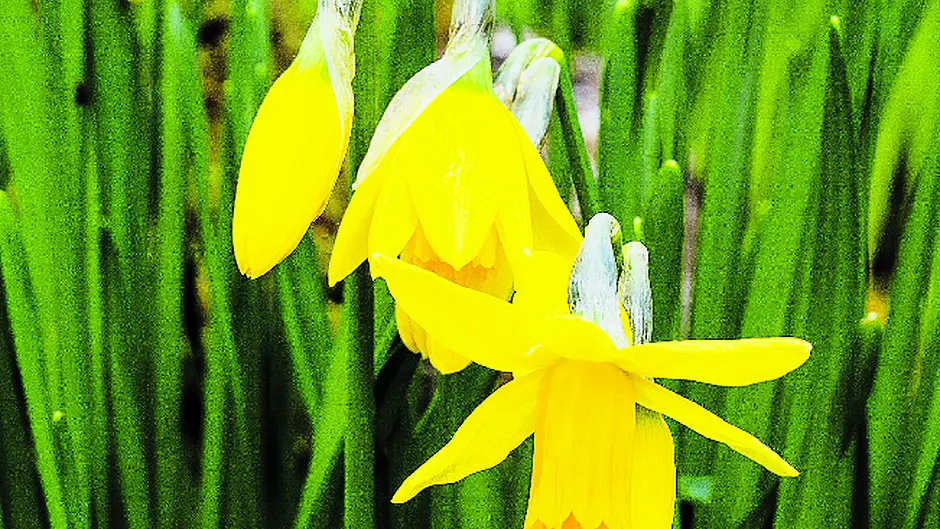There’s a lot happening in the garden.
There’s a lot happening in the garden. Sap rises and things start growing whether we think it is too early or not. Plants are reacting to the signals of a warm winter and they move forward with growth regardless of any warnings of cold weather to come. To be honest, this often happens, although to a lesser degree than we are seeing now. There are dire warnings of new growth being knocked back by January and February chills, and this may happen with a few plants, but most early bloomers are tough enough to keep on with the growth that has started.
Let’s hope that trees and shrubs can keep leaf buds closed for a few more weeks, and a few more after that if a cold snap finally comes.
Daffodils and grass
Some early varieties are already in bloom. They poked through my grass before I had got to the point of doing a final mow and, with stems and grass competing for height, the grass/daff combination looks a bit less smart than I would like it to. There’s little to be done other than scatter some feed to give bulbs a boost, enjoy the display, and smile at these bright heralds of spring whenever they open their blooms in the garden.
I’ve been reflecting on the weather; how grass growth continued so far into the winter and how this can help mitigate some of the worst effects of the extreme rain. Grass helps bind the top layers of the soil together, so less turns to mud or slides off down a slope. It may take a while for the land to dry out, but when it does, I think we will be thankful that the slightly longer grass has helped to keep gardens intact.
Rhubarb growth
I usually ignore the rhubarb bed until stems start to poke up in late January. I then weed everything and mulch the bed with manure, taking care not to cover crowns too deeply.
The rhubarb bed caught me out this year with 12inch tall stems at the New Year. I’ve had to get a move on and clear the weeds from the bed. I had a bit of help, as you may spot in the picture, but the job has now been done.
Stems look a little thin, with this early growth, so I used an organic fertiliser to give plants a faster boost than I usually would.
I don’t want to weaken the crowns too much and I would like them to keep producing healthy stems for the next few months.
I don’t like forcing stems under dark covers, since this does weaken plants, but I have plenty of horticultural fleece lined up in case the weather turns cold. Remember to shake off any snow from covers, if any ever falls and sticks for a while, so you don’t accidently create a dark, forcing environment.
Peas and beans
January is a good month to get early varieties of peas and broad beans into the ground. They can be sown direct in rows if the soil isn’t too wet. Plant peas in double rows, 6in apart and with peas at 2-3in apart in each row.
Allow 8in between the double rows and 6in between seeds in each row for beans sown now. Sow a few extra in case any fail.
Such early sowings always do best if they are covered with a cloche for a bit of extra warmth.
Use a clear polythene cover to shed a little rain and to keep heat in the ground. Put the cloche in place a week before sowing if possible.
Try guttering
If soil is still soggy, or likely to be frozen any time soon, then you can start sowings off in a polytunnel, or greenhouse.
Try sowing peas in a length of guttering filled with compost. Seeds will germinate well with the extra protection.
Take the guttering outdoors and slide the contents into a trench when soil conditions are right for planting. Push the whole lot slowly from one end, or slide as smaller sections. If the contents are hard to slide out: push a bread knife under the end and ease this around as the rootball lifts.
Broad beans need a deeper root run than guttering can provide. Sow in the deepest pots or tubs that you have and disturb roots as little as you can when planting them out. It’s worth noting that sowings two weeks later into the ground can catch up with earlier ones that are pot-raised and then planted out.
Fruit trees and bushes
You can continue to plant or prune fruit trees and bushes, if the weather is mild enough to allow these activities.
Avoid doing either if there are hard night frosts, or if the ground is frozen.
• Joyce Russell is a West Cork gardener/garden writer, and author of ‘The Polytunnel Book — Fruit and Vegetables All Year Round’, the best-selling guide to undercover growing.






